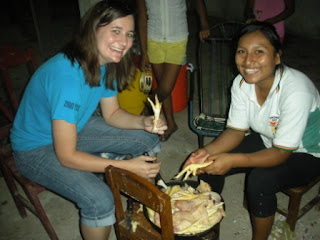GREEN SPHERES
We are fortunate enough to have several fruit trees in our yard. The unfortunate part is that Molly isn’t a big fan of citrus or tropical fruits. I love fruits of all kinds but, being from Iowa, I know absolutely nothing about the growing process of the fruits in our yard. All I know about these fruits, I have learned by observation. I found out that a papaya starts out as a bud, turns into a flower, then from the middle of the flower sprouts a small green fruit that grows and grows and one day fully ripens and turns orange. This is a fascinating process to behold, but it takes a long time and papaya flavor is kind of hit or miss. It is either incredibly refreshing or it tastes like feet.
Along with papaya, we also have bananas, a mango tree, and up until this past week I thought we had two orange trees. One morning, this past week, I went outside and looked under our two orange trees. I saw that under each tree were a few green spheres. I went over to gather the fruit and bring it inside to clean. You might be asking, “Did he say green spheres”? Yes I did. One learns quickly here that you can’t judge an orange by the color of its rind.
After I cleaned the fruit I started to peel an orange from the first tree. Inside it was some of the sweetest and juiciest orange colored citrus I have ever eaten. I was so excited that I decided to peel an orange from the second tree. As I picked at the rind I realized a few things. The fruit inside was far more yellow colored and the sweet aroma that I smelled from the first fruit was not wafting from this citrus. I thought to myself, “Perhaps I was mistaken. Is this a lime tree?” but had to taste the fruit to be sure. As my teeth bit down, the juice trickled down to the back of my tongue and there it settled on the taste buds that trigger the bitter sensation similar to what you might feel if you accidentally inhale bug spray. Then I knew that we most certainly do not have two orange trees. I asked different people what they thought the fruit might be and the most common answer was, “That is one of those good for nothing fruit trees. It doesn’t even make good juice.”
How could this be? The bases of the two trees are only about four feet apart. The trees stand almost the same height. The fruit on the branches looks quite similar with just a small size difference, but what lies beneath the outer layer is completely different from one tree to the next. Then I thought to myself, “I have heard this story before”.
Matthew Chapter 7
15 “Watch out for false prophets. They come to you in sheep’s clothing, but inwardly they are ferocious wolves. 16 By their fruit you will recognize them. Do people pick grapes from thornbushes, or figs from thistles? 17 Likewise, every good tree bears good fruit, but a bad tree bears bad fruit. 18 A good tree cannot bear bad fruit, and a bad tree cannot bear good fruit. 19 Every tree that does not bear good fruit is cut down and thrown into the fire. 20 Thus, by their fruit you will recognize them.
Like I said before, the trees in our yard look the same. It isn’t the appearance of the tree that matters, but the fruit it bears. So what kind of tree are you? Do you bear fruit that is sweet to savor or a bitterness that God wants to spit right back out? Take some time to ponder.
Blessings,
Bryan



Comments
Post a Comment